PATH: HOME, GLOSSARY, WEBSITE INDEX, WEBSITE CONTENTS » ∨
∧ BOAT HAULING & LAUNCHING » Drydocks, Ways, Lifts, Cranes & Hoists » USA »
∧ MEDIA w/Creator Directory » Product Documentation, Books, Magazines, Videos, Websites »
PAGE CONTENTS: (click ⇒ to go to each section on this page)
⇒ Topic Treatment:
⇒ ^ Vendor Directory w/Links to Vendor's Profile, Products, Services,+.
⇒ ^ Related Resources: EAB Topics w/Directories, Vendors, Products: Media: Books, Websites,+.
⇒ Visit EAB's FEATURED ARTICLES Home Page to preview the vast scope of our website.
⇒ This Month's Top 20 Most Popular Articles on our EAB website.
⇒ Layout of the EverythingAboutBoats.org Website's Pages: Page Types, Contents, Topics,+.
⇒ What our nonprofit Anchors Aweigh Academy and its EAB website have accomplished.
⇒ Members must SIGN IN to gain access to Members Only areas of this website.
⇒ Become an Academy Member and gain access to additional pages and programs!
⇒ Comments: Submit To ⇒ Comments♥EverythingAboutBoats.org (Replace "♥" with "@").
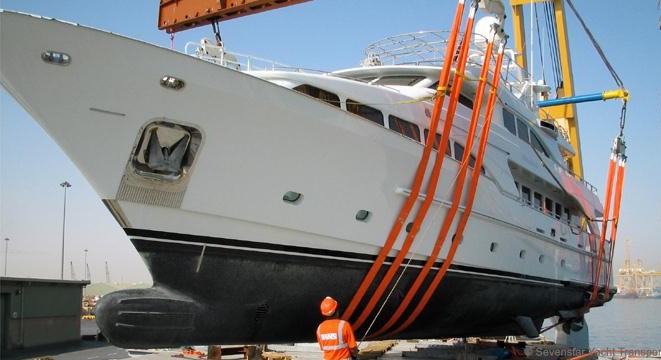
Hauling and Launching of Vessels can be accomplished
at a variety of facilities with equipment including:
Drydocks, Ways, Lifts, Cranes, Hoists and Trailers.
The use of some of these facilities and their equipment
may be dependent heavily on the Weather & Tides.
To Skip this Topic Treatment and go down to the Vendor Directory
CLICK HERE.
Drydocks
Drydocks are of two types: Land based "Graving Docks" and Submersible "Floating Docks".
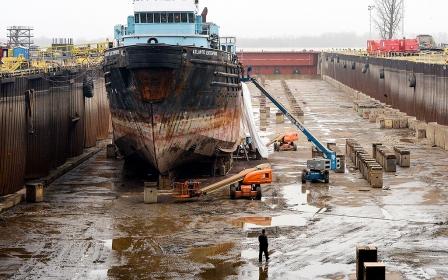 Graving Dock.
Graving Dock.
Graving Docks are the traditional form of drydocks. They are narrow basins next to waterways, usually made of earthen berms and concrete, closed by gates.
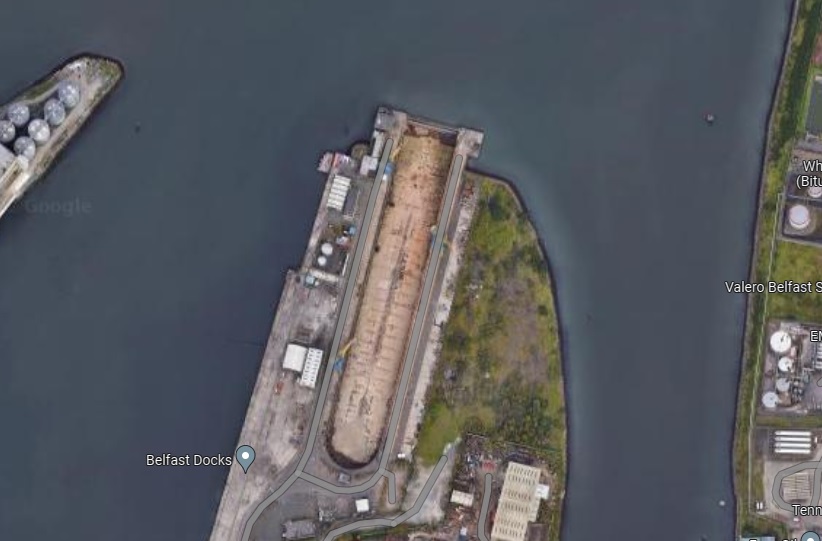 Harland and Wolff Shipyard in Belfast - RMS Titanic's Drydock today.
Harland and Wolff Shipyard in Belfast - RMS Titanic's Drydock today.
Keel blocks as well as the bilge blocks are placed on the floor of the dock in accordance with the "docking plan" of the ship. One or more vessels are floated in with the gates open, then the gates are closed and the water is pumped out, leaving the craft supported on blocks. Routine use of drydocks is for the "graving" i.e. the cleaning, removal of barnacles and rust, and re-painting of ships' hulls. Hull repairs and new construction also takes place within drydocks. The drydock is carefully flooded through ports with valves and the gates opened when it is time to float any vessel out. Large "Graving" docks are the only way to handle very large ships.
 RMS Titanic under construction.
RMS Titanic under construction.
The ill-fated British passenger liner RMS Titanic was built in the largest drydock at the time by the Harland and Wolff shipyard in Belfast (shown in the two pictures above).
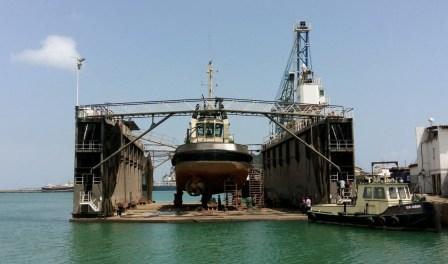 Submersible Floating Drydock.
Submersible Floating Drydock.
Submersible Floating Drydocks are technically vessels with a flat deck and a hull fitted with ballast tanks that are filled with water to submerge the dock so that it can receive one or more vessels. The ballast tanks are pumped out enough to raise the dock's deck above the water so the vessel can be worked on while the vessel is supported on blocks. To relaunch the vessel, the ballast tanks are carefully flooded, submerging the dock enough to float the vessel.
Ways
Ways include "Slipways" and "Marine Railways".
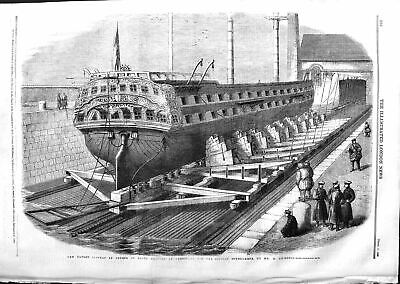 Slipway.
Slipway.
Slipways have been used for centuries in the construction and launching of vessels, large and small. They consist of a ramp for the vessel to "slip" down into the water, typically via gravity. Winches and cables may be used to haul smaller vessels up a slipway for repair or storage. Vessels may ride on a single cradle as shown above or on multiple cradles, or the vessel's hull may ride directly on the ways. The vessel's hull or the cradle(s) and the ways may be coated with grease to reduce friction. Vessels may slip lengthwise (inline with the keel) as shown above, or sideways (perpendicular to the keel) as shown below. Note the spectacular SPLASH!
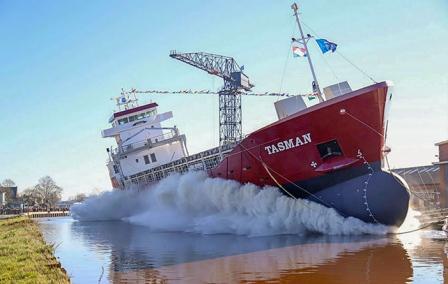 The 90 metre long MV Tasman launching sideways at the Royal Bodewes Shipyard in Hoogezand, Netherlands.
The 90 metre long MV Tasman launching sideways at the Royal Bodewes Shipyard in Hoogezand, Netherlands.
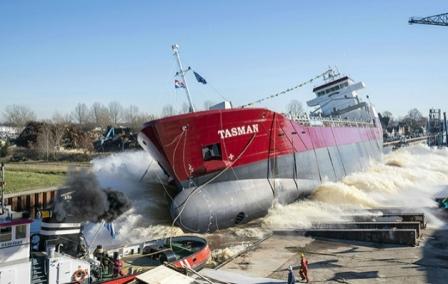 The slipway's ramp timbers can be seen to the right amongst the splash water.
The slipway's ramp timbers can be seen to the right amongst the splash water.
Smaller vessels may ride on a cradle that is sometimes fitted with wheels. When the ramp is fitted with tracks for these wheels, the combination is typically called a Marine Railway.
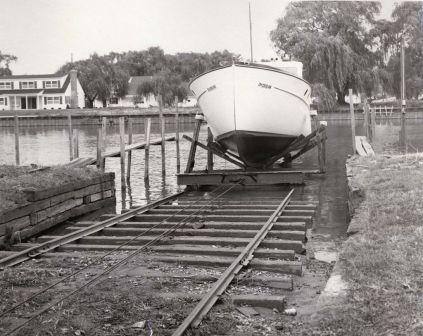 Marine Railway.
Marine Railway.
Marine Railways consist of a ramp leading down into the water fitted with tracks and a cradle for the vessel fitted with wheels. A winch and cable are used to haul the cradle up the ramp and let back down the ramp into the water.
Lifts
Boat Lifts come in a variety of types: Travel Lifts, Fork Lifts, Elevators, and dockside Boat Lifts.
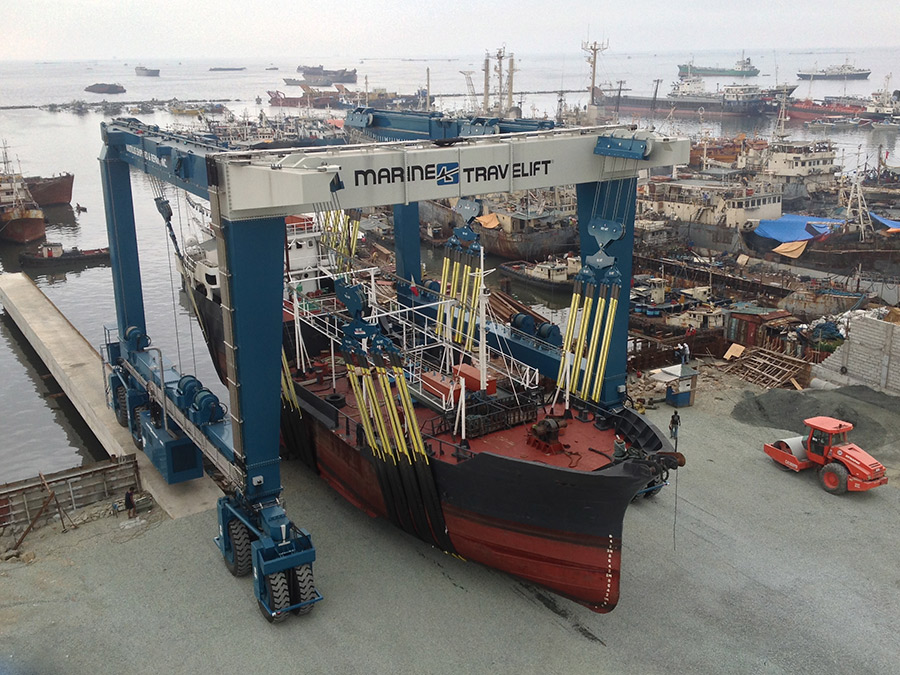 Marine TraveLift.
Marine TraveLift.
Travel Lifts are self propelled wheeled overhead cranes fitted with winches, cables and straps to lift the vessel. They are fitted with at least two straps and can have a dozen straps or more especially if they are lifting large wooden vessels. They usually straddle the opening to the water within a "U" shaped pier as seen above. Travel Lifts can travel around the yard and lower a vessel onto blocks, a cradle or a trailer. Travel Lifts can also perform the reverse to launch.
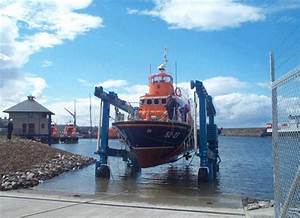 TraveLift going down a ramp into the water.
TraveLift going down a ramp into the water.
Travel Lifts may be driven down a ramp into the water, however this can increase the maintenance to the lift especially in salt water environments.
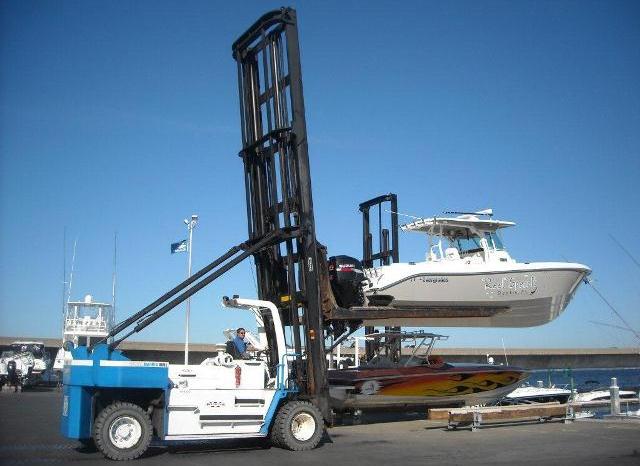 Marine Fork Lift.
Marine Fork Lift.
Marine Fork Lifts are specially built with long sturdy forks covered in soft padding to protect the vessels hull. They are usually driven to the water's edge on a pier or walled dock where the boat is raised or lowered into the water. Fork Lifts may be driven down a ramp into the water, however this can increase the maintenance to the lift especially in salt water environments. On land the vessel is lowered onto foam blocks, wooden blocks and jack stands, a cradle or a rack, or pigeonholed into a stack as shown below.
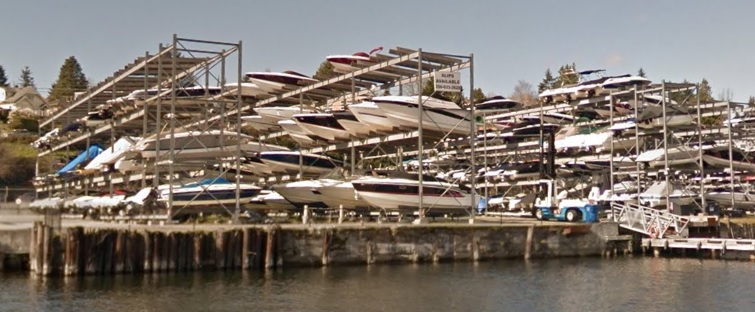 Boat Stacks.
Boat Stacks.
Boat Stacks may be covered by a roof or inside a building, or uncovered as shown above. Boat Stacks allow many more boats to be stored on a smaller parcel of land, however they have sustained far more vessel damage in the event of a fire. Covered stacks help protect the boats from the elements, however they have often sustained even more damage in the event of a fire. Boats housed in Stacks that are equipped with fire sprinklers usually sustain much less damage from a fire. See Boat Stacks.
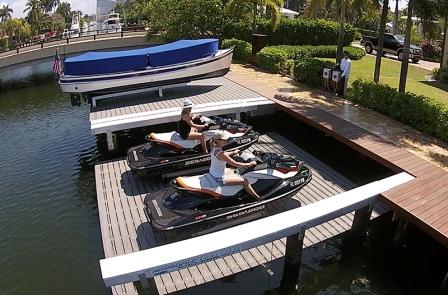 Marine Elevator.
Marine Elevator.
Marine Elevators are flat decked lifts that can lower vessels into the water and lift them out. The elevators shown above are for consumer use, however much larger elevators are in commercial use. Vessels can be inspected or worked on while on an elevator. Some elevators can accommodate multiple vessels. The old three story dry storage Redondo Marina on Puget Sound utilized a two vessel elevator to launch and retrieve boats up to 30' in length. The elevator had transom cradles to support the stern and hoists at the bow to facilitate loading each vessel on a dolly so it could be manually pushed to its designated spot on any of the three floors.
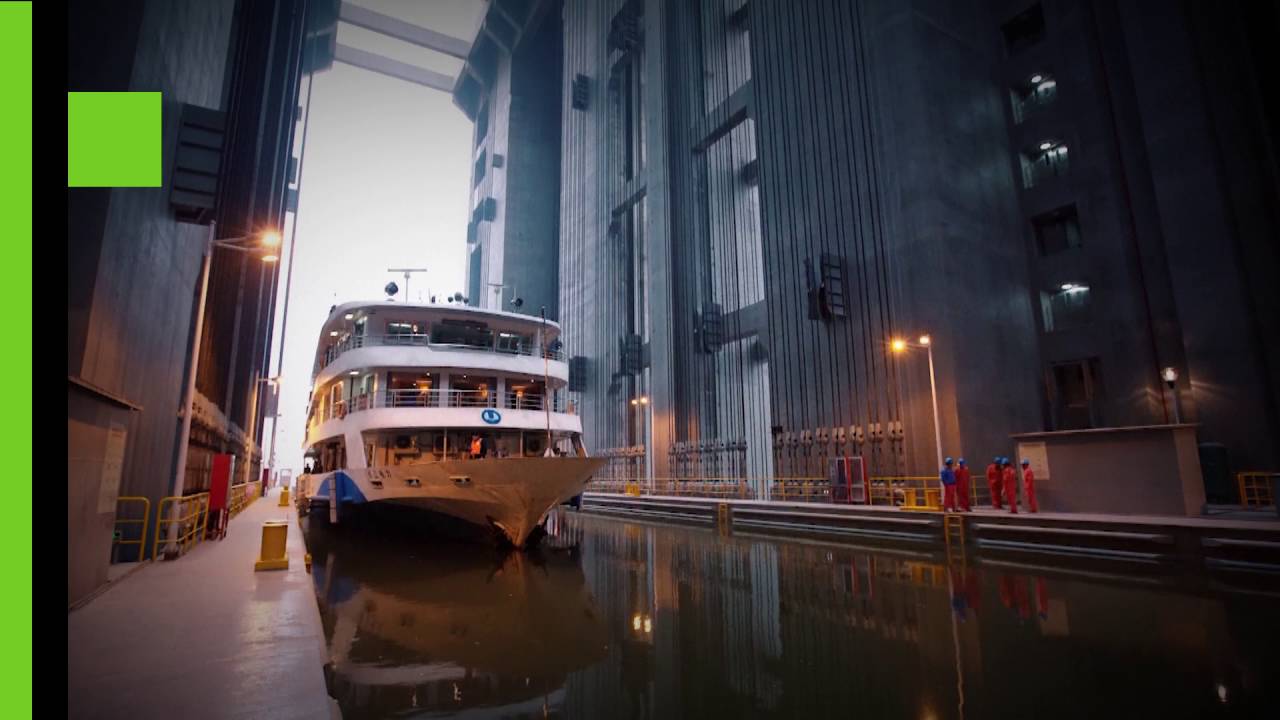 Three Gorges Dam Ship Lift Elevator.
Three Gorges Dam Ship Lift Elevator.
The worlds largest ship elevator is used at the Three Gorges Dam on the Yangtze River in China to move vessels in a 120 m × 18 m × 3.5 m (394 ft × 59 ft × 11 ft) flooded lift basin between the two water levels. It can lift ships weighing up to 3,000 tons the vertical distance of up to 113 m (371 ft) in 40 minutes all while the ship is still afloat in the flooded lift's basin. See Wikipedia.
 Boat Lifts.
Boat Lifts.
Private Boat Lifts are generally fitted with cradles so that the small vessels can be lifted clear of the water. They are appropriate in waters with little tidal action such as lakes. The vessel must be protected from rain water to prevent accumulation of bilge water that might overload the lift causing it to collapse. See Boat Storage Builders for more about Private Boat Lifts.
Cranes
Cranes can be Stationary or Mobile. Mobile cranes can be Overland or Waterborne.
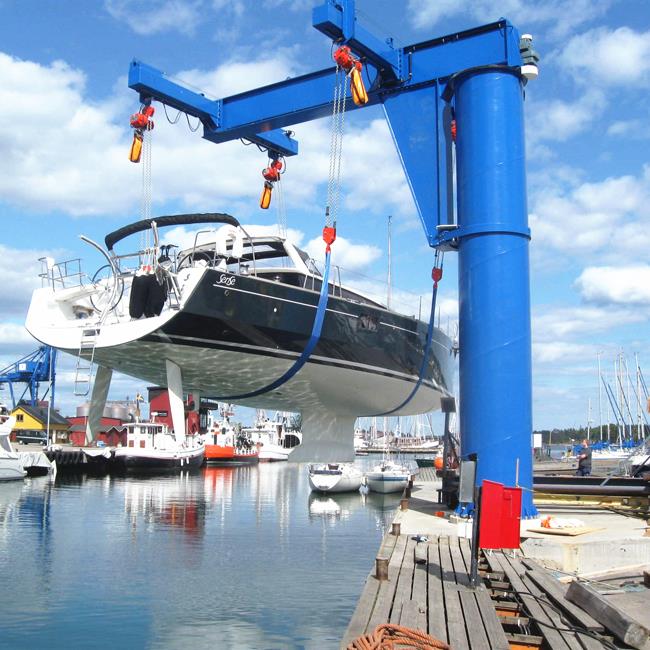 Stationary Crane.
Stationary Crane.
Stationary Cranes are fixed to the shore. They are usually adjacent to flat pads where the vessels can be loaded onto cradles, dollies or trailers. Besides lifting vessels, these cranes can be used to lift engines and other equipment.
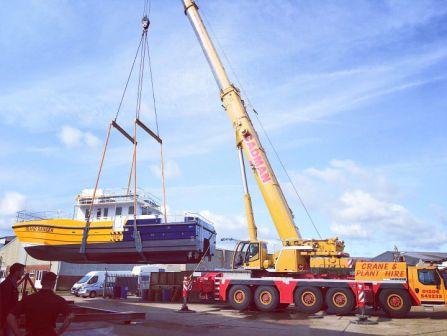 Mobile (Wheeled) Crane.
Mobile (Wheeled) Crane.
Wheeled Cranes are very versatile and can lift boats, engines and other equipment. They are usually fitted with outriggers to support the cranes reach. Caution must be exercised as many mishaps have occurred including cranes tipping over when over-reached and straps slipping, especially when the straps lack 'for to aft' spreaders like the straps above which are too close together on the hull. The 'port to starboard' spreaders visible above help to keep the straps from squeezing the vessel's superstructure. Many automotive tow/recovery trucks are now equipped with boom cranes capable of lifting smaller vessels, engines, equipment, etc.
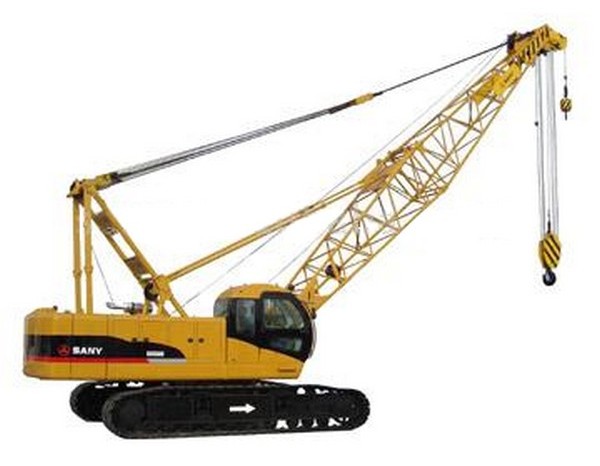 Crawler Tracked Crane.
Crawler Tracked Crane.
Crawler Cranes are also very versatile and can be used on soft, unimproved, or unstable ground, however, they usually lack outriggers and depend entirely on their counterbalance which limits their lifting capacity. They can also be difficult to transport overland from one location to another. A lowboy trailer would be needed for highway travel. They are also regularly transported by rail or barge.
 Rail Tracked Crane.
Rail Tracked Crane.
Rail Cranes run on railway tracks. Rail cranes are most often found in shipyards.
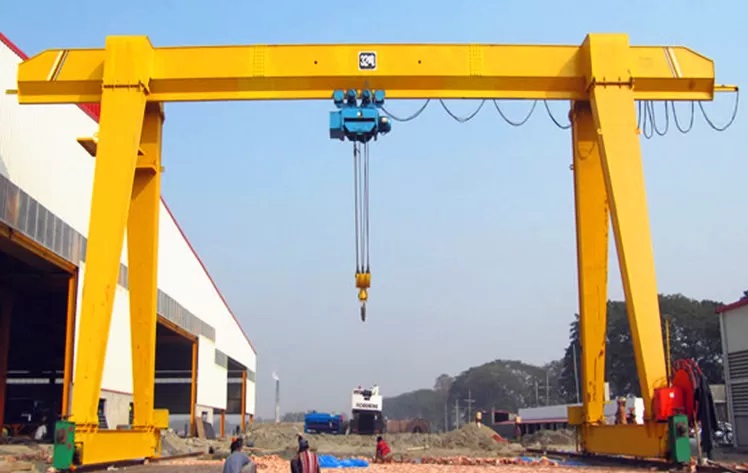 Gantry Crane on Rails.
Gantry Crane on Rails.
Gantry Cranes have a transverse beam fitted with a trolleyed hoist for lifting. Large Gantry Cranes usually roll on rails as shown above. Small Gantry Cranes usually roll on casters as shown below.
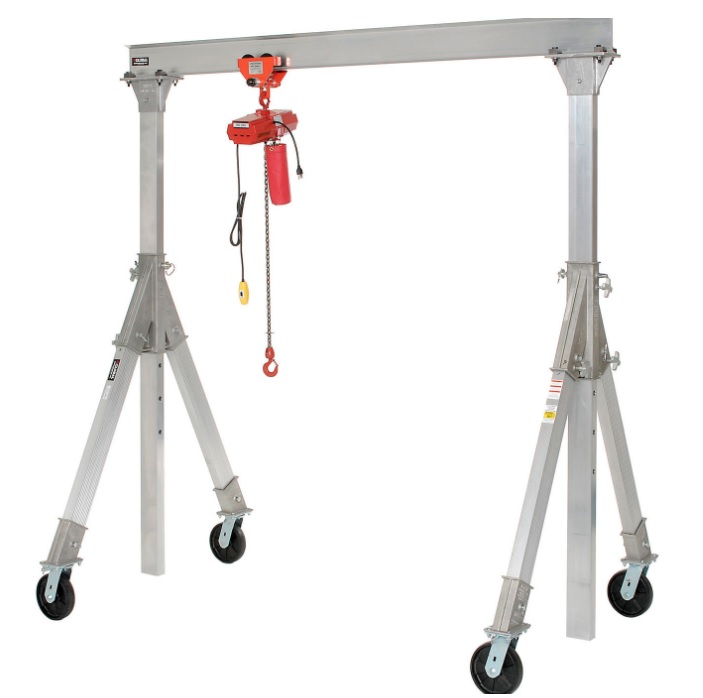 Small Gantry Crane on Casters.
Small Gantry Crane on Casters.
Waterborne Cranes
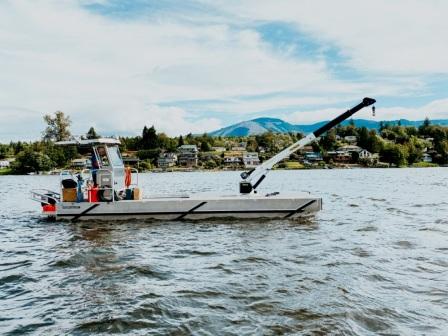 Vessel Mounted Crane.
Vessel Mounted Crane.
Vessel Mounted Cranes come in all sizes, from the small crane shown above that is handy for loading supplies and equipment to the large barge mounted behemoth shown below.
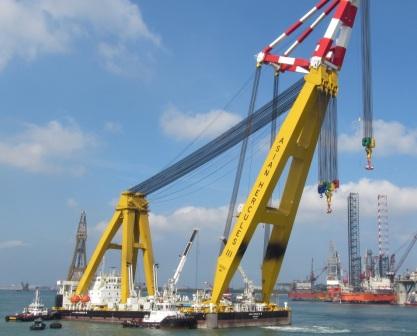 Barge Mounted Crane.
Barge Mounted Crane.
Barge Mounted Cranes like the one above can be used to lift large structures or ships like the yacht pictured at the beginning of this article.
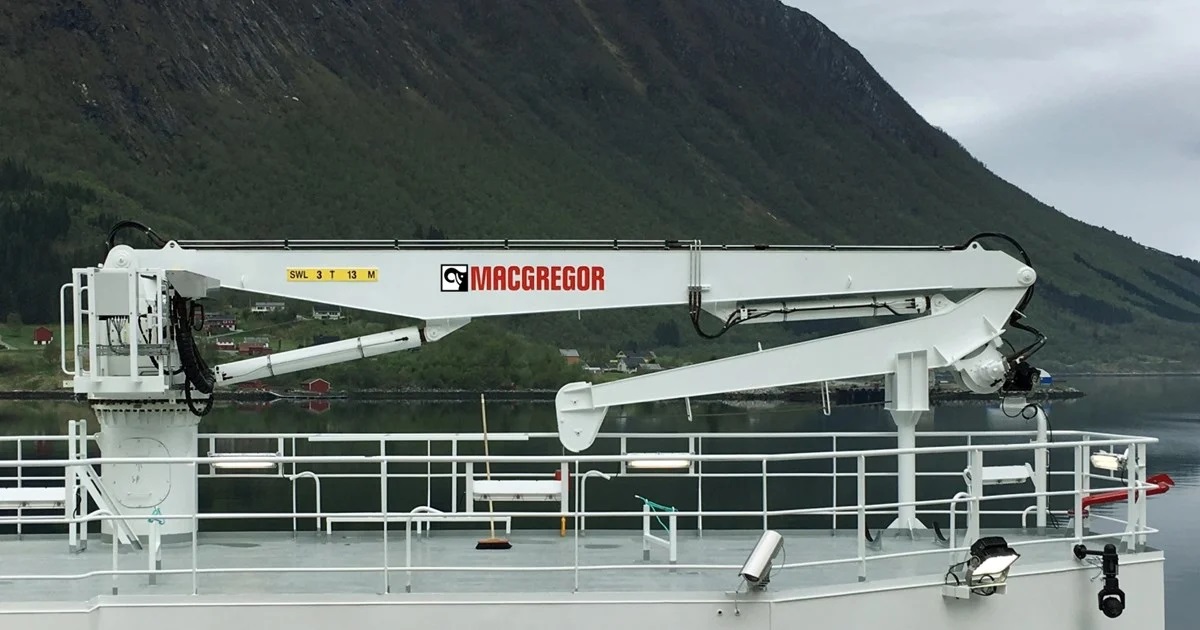 Shipboard knuckleball pedestal Crane.
Shipboard knuckleball pedestal Crane.
Shipboard Cranes are very common and are used to handle ship's stores, equipment or cargo.
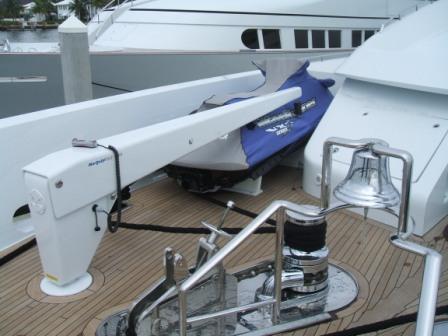 Tender Crane.
Tender Crane.
Small Shipboard Cranes can handle the ship's supplies and tender like the PWC above. See Deck Hardware & Equipment for more about Shipboard Cranes.
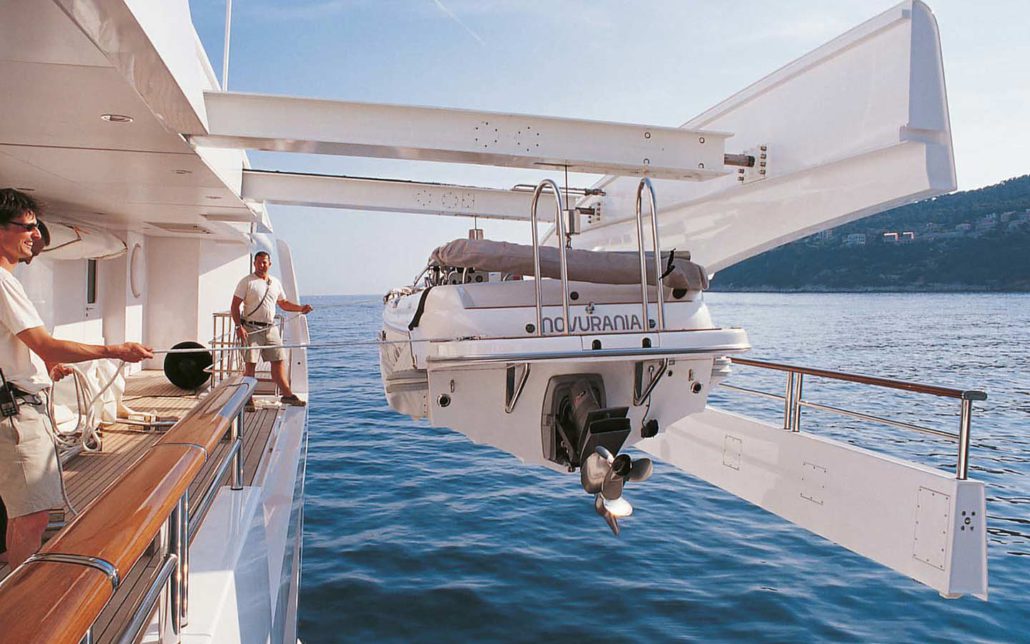 A Custom Shipboard Crane handling a mega-yacht's high-performance tender.
A Custom Shipboard Crane handling a mega-yacht's high-performance tender.
Shipboard Cranes that exclusively handle the ship's tender are typically called Davits and come in various sizes from the large custom built-in design above to the smaller dingy davits below.
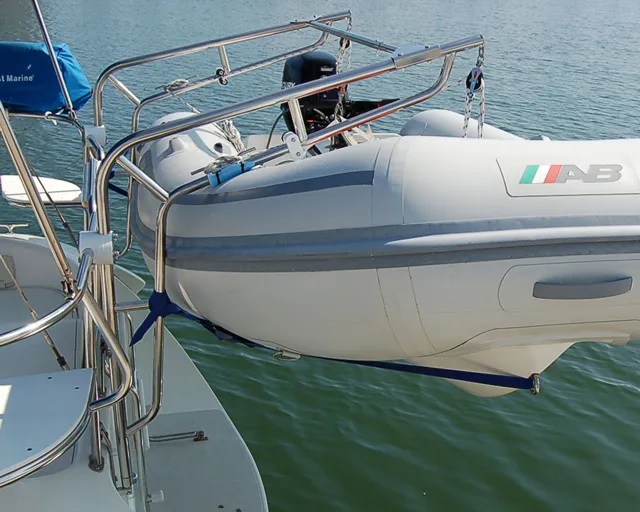 Dingy Davits.
Dingy Davits.
Dingy Davits are simple and easy to use. They save wear and tear on the dingy, the parent vessel and the crew. See Deck Hardware & Equipment for more about Davits.
Hoists
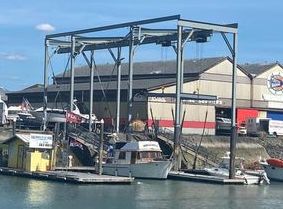 Overhead Trolley Travelling Hoist with lifting straps.
Overhead Trolley Travelling Hoist with lifting straps.
Overhead Trolley Travelling Hoists are used primarily by commercial trailer-boat launchers and employ winches, cables and straps to lift private boats off their trailers and then move the boat along the overhead beam/track via wheeled trolley(s) to where they are launched. Boats are retrieved by reversing the operation. Some boatyards also use them to lift and launch boats for repair, etc. Overhead Trolley Hoists are more common in areas where they need to achieve considerable lifting elevation due to high banks, high range of tides, etc.
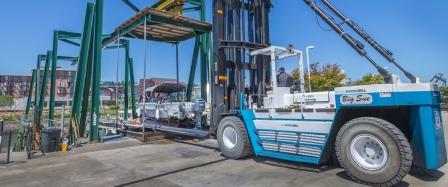 Overhead Trolley Travelling Hoist with suspended boat cradle.
Overhead Trolley Travelling Hoist with suspended boat cradle.
Instead of straps, the hoist may be fitted with a suspended flat deck or boat cradle (like the one above) where the vessel is placed with a fork lift before traveling down the track where the boat and cradle are lowered for the launch. Boats are retrieved by reversing the operation.
Trailers
Boat Trailers can launch and retrieve boats by using Boat Launch Ramps (which are
technically Ways), or travel lifts, cranes and overhead track hoists with straps.
See Boat Trailers for trailer types, features, maintenance and vendors.
See Recreational Boating Seamanship Training for Trailer Towing.
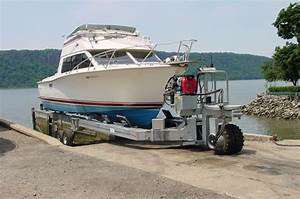 Self-Propelled Boat Trailer/Carrier.
Self-Propelled Boat Trailer/Carrier.
Self-Propelled Boat Trailers/Carriers are specially built to accommodate boats of various types and sizes. They are typically driven down a ramp into the water to launch and retrieve boats. They are used primarily by yacht brokers, repair yards, and boat storage yards to launch and retrieve boats for sale, repair or storage in their yards, Boats are typically set on blocks while in their yards.
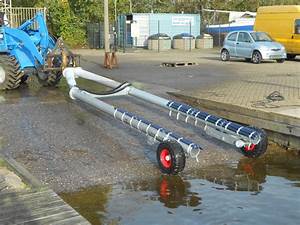 Yard Trailer.
Yard Trailer.
Yard Trailers are custom made to haul and launch vessels of different types and sizes so they can be worked on in the boatyard. They are not typically roadworthy trailers.
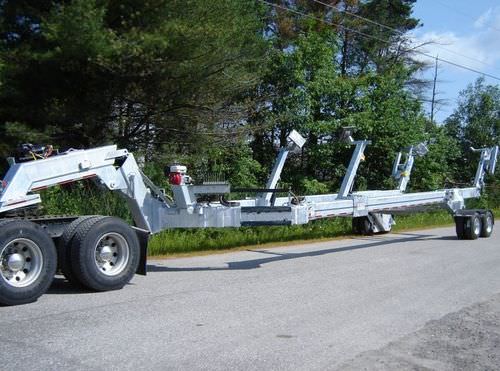 Boat Transporter's Trailer.
Boat Transporter's Trailer.
Some boat transporters have specially built road trailers that can adjust to the various boat bottoms including some sailboats. Some of these trailers can even launch and retrieve boats by going down launch ramps. See Boat Transport Over-Land for Boat Transporters.
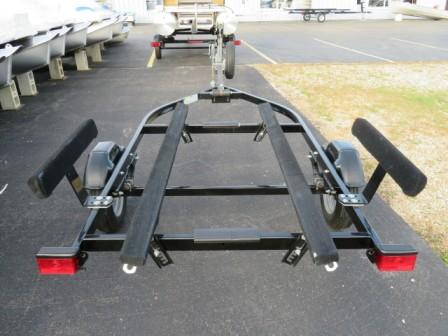 Bunk Trailer.
Bunk Trailer.
Bunk Trailers are the most popular trailer on the road these days. However, when wet launching, they must be dunked deeper to get the boat to float off the bunks, especially if the ramp has the wrong grade. Boat trailers that are used to wet launch boats especially in salt water require much more maintenance of wheel bearings & brakes. See our webpage on Boat Trailers for more about trailer maintenance, galvanizing and the "Bearing Buddy" secret.
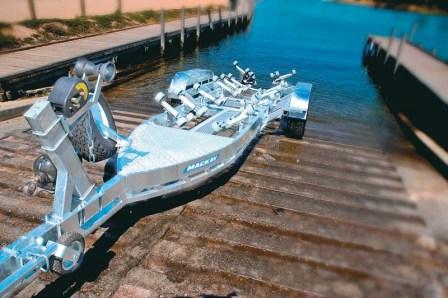 Roller Trailer.
Roller Trailer.
Roller Trailers can wet launch boats much more easily then bunk trailers. However they are more expensive and must have adequate rollers to support the vessel and not damage the hull. Roller trailers require more maintenance then bunk trailers. Take note that the roller supports often wear and sometimes sheer their pivot bolts allowing the boat to settle onto the trailer's framing and damaging the hull, or worse yet, roll off the trailer unto the highway. See our webpage on Boat Trailers for more about trailer maintenance.
The use of some of the above facilities and equipment may be dependent on the
Weather & Tides.
Vendor Directory
⇒ Directory Under Development ⇐
Drydocks, Ways, Lifts, Cranes & Hoists by Locale
+ΞLocaleΞ
+ΞVendorΞ
+ΞLocaleΞ
+ΞVendorΞ
Please do not try to contact any of the vendors on this website via our EverythingAboutBoats.org Phone, Email or Comment Systems. Your message will NOT be forwarded to the vendor.
Contact vendors directly (if still active).
If any vendors should be added to this Directory, please submit their info/links via email To:
Editor♥EverythingAboutBoats.org (Replace "♥" with "@").
Related Resources:
Topic Pages w/Directories, Vendors, Products: Media: Books, Websites, etc.
Categorized by Topic & Hierarchy w/Links (Sitemap).
TABLE KEY: Resource Types are identified by the following Resource Codes (RC).
T = Topic Page.
TD = Topic Page w/Directory
V = Vendor Page.
VO = Vendor's Offerings.
VW = Vendor's Website.
MV = Media Vendor/Creator.
MS = Media Source.
P = Product Page.
PD = Product Documentation.
B = Book.
BB = Book - Biography.
BE = Book Excerpt.
BF = Book - Fiction.
M = Magazine.
MI = Magazine Issue.
MA = Magazine Article.
Vid = Video.
W = Website.
WA = Website Article.
WV = Website Video (incl. YouTube).
F = Forum.
FP = Forum Post.
S = Social Media.
SP = Social Media Post.
NOTES: Resource Codes are arranged above by resource directory hierarchy.
Resource Codes are displayed in the Right Column labeled "RC". ⇒ ⇒ ⇒ ⇒ ⇒ ⇒ ⇒ ⇒ ⇒ ⇓
Resource Codes which are BOLD indicate Media is available from our Academy eLibrary.⇒ ⇓
^ To view Media, Click on the Media Title to go to our webpage for that media and then:
^ ^ Scroll down to the Academy eLibrary section for media viewing instructions.
Resource Media (Books, Magazines, Videos, etc.) Titles are displayed in a smaller font.
Resource Titles below are arranged by hierarchy using "^" to show subordination.
Resource Links which are BOLD lead to EverythingAboutBoats.com ON-SITE pages.
Resource Links which are NOT BOLD lead OFF-SITE. We is not responsible for their content.
If a link fails or we should add a resource to this listing, please submit info via email to:
^ Editor♥EverythingAboutBoats.org (Replace "♥" with "@")
If any Related Resources should be added to this list, please submit info/links via email To:
Editor♥EverythingAboutBoats.org (Replace "♥" with "@")
NOT AN ACADEMY MEMBER?
CLICK HERE to discover how you can become a Member and gain FULL access to
thousands of expanded pages and dozens of excellent programs including our eLibrary!
CLICK HERE to view ALL the books, magazines, videos, etc. in our Academy eLibrary.
Media are also listed by category on the Topic Pages found on the Right Sidebar ⇒
CLICK HERE to donate any books, magazines, manuals, or videos, etc. to our Library.
EVERYTHING ON THIS PAGE OK?
If there is anything on this webpage that needs fixing, please let us know via email To:
Editor♥EverythingAboutBoats.org (Replace "♥" with "@")
THIS ARTICLE IS STILL EVOLVING!
The page may contain rough drafts that include raw source materials.

Visit our FEATURED ARTICLES Home Page
to see examples of our website's comprehensive contents!
Thanks to our amazing contributors for the steady flow of articles, and to our dedicated all-volunteer staff who sort, polish and format them, everyday we get a little bit closer to our goal of
Everything About Boats. If you would like to submit an article,
See Submitting Articles.
— TOP 20 MOST POPULAR ARTICLES —
Detroit Diesel 8.2 Liter “Fuel Pincher” V8 Engine
Cummins V-555 & VT-555 “Triple-Nickel” V8 Diesel Engine
Lehman 120 (6D380) Diesel Engine (Ford 2704C & 2715E)
Ford Industrial Power Products Diesel Engines
How to Identify Ford Diesel Engines
Ford 2715E Diesel Engine
Lehman Mfg. Co.
Perkins Engines
Universal Atomic 4
Sears Boat Motors: Motorgo, Waterwitch, Elgin, etc.
Chrysler & Force Outboards
Eska Outboard Motors
Allison Transmission
ZF Friedrichshafen AG
Marine Surveyors by Country
American Marine Ltd (Grand Banks)
Boat Inspection (Types of Marine Surveys)
Boat Builders: (A∼Z) (w/Vessel Types, Locale & Years Active)
USCG NVIC 07-95 Guidance on Inspection, Repair and Maintenance of Wooden Hulls
American Boat and Yacht Counsel (ABYC)
Layout of the EverythingAboutBoats.org Website's Pages
— Types of Webpages —
This website consists almost entirely of 3 types of webpages as follows:
- TOPIC PAGES (See Main Topic Pages listed on Website Contents or the Right Sidebar) ⇒
- EXAMPLE: – WEBSITE CONTENTS w/Links to MAIN TOPIC & Subtopic Pages:
- EXAMPLE: 02 – BOAT BUILDING, OUTFITTING, REFITTING & REPAIR:
- EXAMPLE: 02.06 – Boat Equipment:
- EXAMPLE: 02.06.08 – Propulsion Machinery:
- EXAMPLE: 02.06.08.01 – Engines w/Directory of Vendors.
- VENDOR PAGES (Vendors of Products, Services, Events,+, Destinations & Media Creators)
- EXAMPLE: 02.06.08.01 – ^ Ford Industrial Power Products Diesel Engines.
- PRODUCT PAGES (Equipment, Events, Media: pDoc, Books, Magazines, Videos, Websites,+)
- EXAMPLE: 02.06.08.01 – ^ ^ Ford 2715E Diesel Engine.
- EXAMPLE: 02.06.08.01 – ^ ^ Ford OpManual - 2710 Range Diesel Engines.
- EXAMPLE: 02.06.08.01 – ^ ^ Ford Service Manual - 2700 & 2710 Range Diesel Engines.
Clickable Links that lead to other webpages appear in Blue Text and usually open in a new window.
Links in the Right Sidebar and most directories open in the current window, not a new window.
Note in the examples above that these pages form a natural hierarchy.
The unnumbered "^" pages are listed alphabetically in most tables.
Media Titles in tables are distinguished by their smaller font size.
Media (Books, Magazines, Videos, Articles,+) are treated as Products.
Vendors' Product Documentation (pDoc) are considered Media.
Destinations & Media Creators are treated as Vendors.
All Website Pages are optimized for viewing on
full-width disktop computer monitors,
but can be viewed on phones.
— Contents of Webpages —
Website Pages typically contain the following Sections:
- PATH (Shows the chain of EAB pages w/links that lead to the page being viewed).
- EXAMPLE:
PATH: HOME, WEBSITE INDEX, WEBSITE CONTENTS » ∨
∧ BOAT BUILDING & REPAIR » Boat Equipment » Propulsion » Engines » ∨∨
∧∧ Ford, Ebro, American Diesel, AmMarine, Barr, Beta, Bomac, Bowman, Couach,
Lees, Lehman, Mermaid, Parsons, Renault, Sabre, Thornycroft, Wortham Blake »
∧ DO-IT-YOURSELF » DIY Boat Building & Repair » DIY Schools & Classes »
∧ MEDIA w/Creator Directory » Documentation, Books, Magazines, Videos, Websites » - (The "»" right pointing Guillemet symbol shows the chain through the page links.)
- (The "," comma between page links in the chain indicates pages are not subordinate, but are instead at the same level. See engine brands in the example above.)
- (The "∨", "∨∨", "∨∨∨",+ symbols indicate that the path line continues with whatever follows the "∧", "∧∧", "∧∧∧",+ symbols respectively. "∧" Precedes each MAIN TOPIC Page.)
- EXAMPLE:
- PAGE CONTENTS (Table of Contents with links to each main section on the page).
- PAGE BODY (The type of page determines the contents of its body as follows:).
- TOPIC PAGES (Topic Treatment: Introduction, Overview, Background, Details,+).
- (Many Topic Pages contain Directories of Vendors with Links).
- (Most Directory Listings are Alphabetical and/or by Locale).
- VENDOR PAGES (Vendor's Profile, Contact Information, Products, Services,+).
- (Manufacturers, Resellers, Refitters, Yards, Surveyors, Clubs, Schools, Authors,+).
- (Boating & Travel Destinations are treated as Vendors on their own Vendor Pages).
- PRODUCT PAGES (Product Features, Vendor Links, Specifications, Documentation,+).
- (Media created by a vendor is often treated as a Product on its own Product Page).
- (Boating & Travel Events are often treated as Products on their own Product Pages).
- TOPIC PAGES (Topic Treatment: Introduction, Overview, Background, Details,+).
- RELATED RESOURCES (Topics, Vendors, Products, Media: Books, Websites,+ with Links).
- PAGE TAIL Contains the following Anchors Aweigh Academy & EAB Website Features:
- The Anchors Aweigh Academy's EverythingAboutBoats.org Header.
- A link to our Featured Articles EAB Home Page.
- Top 20 Most Popular Articles. (The section that appears right above ⇑ this section).
- Layout of the EverythingAboutBoats.org Website's Pages. (This very section ⇐).
- Topics of Webpages. (The very next section below ⇓).
- What we have accomplished so far.
- Members must Sign-In to gain full access to Expanded Pages & Programs.
- Sign-Up (if not already a member).
- Public Comments (about the website & about this page).
- RIGHT SIDEBAR (Website Contents menu with links to Main Topic & Subtopic pages).
(On some smart phones, the Right Sidebar may appear at the bottom of the webpage)
— Topics of Webpages —
Website Pages are categorized under the following 16 MAIN TOPICS:
The MAIN TOPICS follow a natural progression from conception of the vessel thru its
building, marketing, survey, financing, insuring, transport, moorage, use and upkeep.
The MAIN TOPICS (all Caps) below are followed by their Main Subtopics with Links.
00 – HOME: CONTENTS, ABOUT EAB: Contact EAB, Abbreviations & Symbols, FAQ, GLOSSARY, ADs,+.
01 – ABOUT BOATS w/Museum Directory: Early History, Recent History, Modern Vessel Types,+.
02 – BOAT BUILDING, OUTFITTING, REFITTING & REPAIR: Materials, Equipment, Builders,+.
03 – BOAT MARKETING: Boat Shows, Dealers & Brokers, Importing & Exporting, Auctions & Sales,+.
04 – BOAT INSPECTION: Types of Marine Surveys, Marine Surveyors, Schools, DIY Inspections,+.
05 – BOAT TITLES & VESSEL REGISTRY: Boat Title & Registration, Vessel Registry, Title Co's,+.
06 – BOAT FINANCING: Conventional (Banks, Credit Unions,+), Unconventional (Creative),+.
07 – BOAT INSURANCE: Maritime & Recreational: Coverage, Carriers, Agents,+., Claim Processing,+.
08 – BOAT TRANSPORT: By Sea (Piggyback, Delivery Skippers & Crews, & Towing), Over-Land,+.
09 – BOAT HAULING & LAUNCHING: Drydocks, Ways, Lifts, Cranes & Hoists, Launch Ramps,+.
10 – BOAT MOORAGE & STORAGE: Builders, Anchorages, Marinas, Yards, Racks & Stacks,+.
11 – BOATING ORGANIZATIONS: Yacht Clubs & Sailing Clubs, Paddling Clubs, Boat Owners,+.
12 – BOATING & TRAVEL: Events, Destinations, Boat Rentals & Charters, Cruises, Voyages,+.
13 – BOATING & MARITIME EDUCATION: Recreational Seamanship, Ship's Master & Crew,+.
14 – MARINE LAWS & REGULATIONS: International & National Laws‚ Lawyers‚ Investigators‚+.
15 – DO-IT-YOURSELF: DIY Boat Building & Repair, DIY Boat Sales, DIY Boat Surveys, DIY Classes,+.
16 – MEDIA w/Creator Directory + Academy eLibrary: pDocs, Books, Magazines, Videos, Websites,+.
The above MAIN TOPICS and a more detailed listing of Subtopics
can be found on the Website Contents page and on the Right Sidebar.
An Alphabetical Index of the website can be accessed at Website Index.
What we have accomplished so far.
Anchors Aweigh Academy and its EverythingAboutBoats.org website.
- Published over 50,000 website pages about boats and boating, bringing us closer to reaching our goal of becoming "The ultimate reference resource about boats and ships for everyone from the beginning recreational boater to the seasoned professional mariner!"
- Published over 300 website main topic webpages, many with full articles on the topic. See our Website Contents or the Right Sidebar for the listing of the main topic pages.
- Published over 9,000 marine vendor webpages, all with their contact information, most with a description of their products and services, many with product documentation, specifications and independent reviews. (incl.: Boat designers, boat building tools, material and equipment manufacturers and suppliers, boat builders and dealers, yacht brokers, marine surveyors, boat insurers, boat transporters, skippers and crews, boatyards and marinas, yacht clubs, boat rentals and yacht charters, boating, seamanship and maritime schools, marine law attorneys and expert witnesses, boat refitters and repairers, book authors, magazine publishers, video producers, and website creators)
- Acquired over 120,000 pages of product documentation including Catalogs, Brochures, SpecSheets, Pictures, Serial Number Guides, Installation Manuals, OpManuals, Parts Catalogs, Parts Bulletins, Shop Manuals, Wiring Diagrams, Service Bulletins, and Recalls. And have made all viewable to Academy Members through our EAB website eLibrary.
- Acquired over 1,200 books and magazine back issues in our academy library and so far have made over 700 viewable to Academy Members through our EAB website eLibrary.
- Published over 500 DIY How-To articles about boat design, construction, inspection, operation, maintenance, troubleshooting and repair. We are working hard to do more.
We are currently formatting and polishing the Anchors Aweigh Academy online and hands-on courses. Our Marine Surveying course has proven to be excellent for both the beginner and the seasoned surveyor, and especially helpful to the Do-It-Yourselfer.
Current Academy Members must SIGN IN to gain FULL access to this
website including expanded pages and valuable Academy programs
like our Academy eLibrary and our Ask-An-Expert Program!
If your membership has expired, CLICK HERE to Renew.
IF YOU ARE NOT YET AN ANCHORS AWEIGH ACADEMY MEMBER,
CLICK HERE to discover how you can become a Member and gain FULL access to
thousands of expanded pages and articles, and dozens of excellent programs
WITH JUST A SMALL DONATION!
Comments for Public Viewing
Submit any comments for public viewing via email To: Comments♥EverthingAboutBoats.org (Replace "♥" with "@")
Please remember to put this webpage's title in the subject line of your email.
All comments are moderated before they appear on this page. See Comment Rules.
General Comments About the Website
FROM Donald: "This is an awesome website. I found the information that I needed right away from one of the over 20,000 free articles that you provide as a public service. I'm surprised that so much if this site is free. But I still signed up so I could access the thousands of expanded pages, interesting articles, and dozens of valuable programs! The member's library of books, magazines and videos that I can view online is really terrific! I understand that you and your staff are all unpaid volunteers. Please keep up the good work. And I commend you for your plans to add another 10,000 free informative articles over the next year. I'm thrilled to support you in this endeavor with my small membership donation. Thanks again for all your hard work."
FROM Huey: "I agree with my Uncle, I too have found the articles to be very enlightening. They say that it will take about 100,000 articles to cover the full scope that they have envisioned for the website. They have over 20,000 articles so far and that's doing pretty well, but it could take several years to get the rest. I also noticed that many of the Main Topic Pages and some of the article pages are still in the rough draft stage. I guess that they will fill in as they can get volunteers to work on them. But what I can't figure out is why anyone would spend the time writing informative in depth articles just to give away free to this website for publication? What's in it for them?"
FROM Dewey: "Well Huey, to me It looks like most of the articles on this website are written by very informed people, like boating instructors, boat designers, boat builders, riggers, electricians, fitters, marine repair technicians and marine surveyors. Writing such articles helps establish them as knowledgeable professionals. After all, this website was originally created by a school for marine technicians and marine surveyors. The website is growing in content every day. They even had to move to a bigger, more powerful server because the website's traffic has been growing exponentially."
FROM Louie: "I agree with everyone above. This site is quickly becoming the ultimate reference resource about every aspect of boats and ships for everyone from the beginning recreational boater to the seasoned professional mariner. I use the topic pages on the right sidebar to browse around the website. It's like a Junior Woodchucks' Guidebook for Boaters. Their Members' Library of over 300 popular and obscure books and over 200 magazine back issues that can be viewed online is fabulous. The Academy's magazine is especially informative. On top of that, there is the "Ask-An-Expert program for members where you can get an expert's answer to any of your boat questions. And a whole years membership is only $25. What a deal! I really love being part of this "Everything About Boats" community and help provide thousands of helpful articles free to the public. I think that I'll sit down right now and write an article about my experiences boating with my uncle."
FROM Scrooge: "You rave about this website like it was the best thing since sliced bread. Well, I think it stinks. Sure, it has a lot of good information for boaters, and they're adding more every day, but it will probably never be finished. Furthermore, I don't even own a boat. And I wouldn't have a boat even if someone gave me one. Boats are a waste of money and time and energy and money! They're just a hole in the water you pour money into. If you gave me a boat, I'd sell it quicker then you could say Baggywrinkle. Then I'd lock up the cash with all my other money so I could keep my eye on it and count it every day. Bah humbug."
FROM Daisy: "I'm just so glad that Donald got the boat so we and the boys could enjoy boating — together. And of course all of the girls, April, May, and June, love to be on the water too, especially when that is where the boys are. Oh poor Scrooge, boating is more fun then you could possibly imagine."
FROM Scrooge: "After seeing how much fun you all have on the water together, I regret that I didn't have that much fun when I was young. I've had a change of heart, and I'm giving each of you a Lifetime Academy Membership."
FROM Editor: "For those of you that have stayed with us this far, many thanks, and we hope that you found this little narrative informative. Your faithful support inspires us to keep working on this phenomenal website. We know that we have a lot more to do. Ultimately, we hope that we can help you enjoy the wonder filled world of boating as much as we do. We are all waiting to see what you have to say about this webpage article. Submit any comments via email To: Comments♥EverythingAboutBoats.org (Replace "♥" with "@"). Be sure to include this page's title in the subject line. Also, your corrections, updates, additions and suggestions are welcomed. Please submit them via email To: Editor♥EverythingAboutBoats.org (Replace "♥" with "@"). It has been truly amazing to see what we have been able to accomplished when we've worked together. Thanks to all those that have donated their valuable time and energy, and a special THANK YOU to all that have supported this cause with their membership donations."
Comments About This Particular Page
FROM ΞNameΞ: “Be_the_next_to_comment_about_this_page.” {230316}